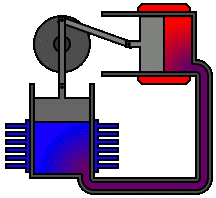When it comes to the world of novel power machines and devices, Peltier coolers and Stirling engines are at the top of the heap.
The Stirling engine, a novel heat engine developed by Robert Sterling in 1816, the key principle of a Stirling engine is that a fixed amount of a gas is sealed inside the engine. The Stirling cycle involves a series of events that change the pressure of the gas inside the engine, causing it to do work.[1]
Heat applied,
- If you have a fixed amount of gas in a fixed volume of space and you raise the temperature of that gas, the pressure will increase.
- If you have a fixed amount of gas and you compress it (decrease the volume of its space), the temperature of that gas will increase.
One cylinder is heated by an external heat source (such as fire), and the other is cooled by an external cooling source (such as ice). The gas chambers of the two cylinders are connected, and the pistons are connected to each other mechanically by a linkage that determines how they will move in relation to one another.
A modern conceptualization of the Stirling engine is helping to bring lighting to under developed communities. Dean Kamen, an entrepreneur in Bangladesh, developed a Stirling engine that is so far powering three remote villages. What particularly suits the Stirling for the developing world is that it can burn any liquid or gas fuel, and unlike other engines, it can tolerate fuel with impurities. Most generators can’t do much with carbon-dioxide-infused methane released by decomposing cow manure, but the Stirling is happy with it[2].
Thermoelectric cooling uses the Peltier effect to create a heat flux between the junction of two different types of materials. A Peltier cooler, heater, or thermoelectric heat pump is a solid-state active heat pump which transfers heat from one side of the device to the other, with consumption of electrical energy, depending on the direction of the current. Such an instrument is also called a Peltier device, Peltier heat pump, solid state refrigerator, or thermoelectric cooler (TEC).
Applying current across the junction, creates a hot side and a cold side. This feature can then be exploited to cool or heat an object and only electricity is required. Many cars today that have console drink coolers utilize this technology. [3]
Whether providing a modern convenience, such as the beverage cooler, or the more fundamental gift of providing electricity to help lift marginalized people out of poverty. Technology mustn’t necessarily be new to have a new affect on the world.
Sources:
[1] http://auto.howstuffworks.com/stirling-engine1.htm
[2] http://spectrum.ieee.org/energy/renewables/empire-off-the-grid/gridsb01
[3] http://en.wikipedia.org/wiki/Thermoelectric_cooling

